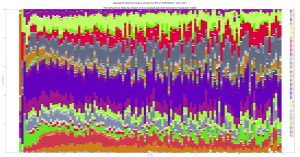Behavior-based Lead Scoring, Fraud Detection & Compliance
Whenever you try to generate new business, you face one big question:
Which leads should you focus your energy on to increase your speed to lead?
The obstacles that prevent you from knowing the answer are as old as marketing itself:
-
Fraud
-
Compliance
-
Lead conversion
At Oxford BioChronometrics, we have a solution that removes those obstacles and tells you how likely a given lead is to become a customer. It actually provides you with an “Intention Score” so that you can see how likely a lead is to become a customer.
Lead Gen Risks in a Nutshell
No matter how you get your leads, their quality is a concern. Bad leads drain your budget and waste your time. And there are two major headaches that come with them:
- First, there’s fraudulent traffic. Whether the cause is a malicious affiliate, bad luck or anything else, fraudulent traffic generated by bots turns your hard-earned money into waste and loss. Old-school solutions look for the same old things again and again – device fingerprints, user agents, IP lists, and so on. But fraud is a big business and they know how to avoid getting caught. Some even hire actual humans in Third World countries to commit fraud that won’t get caught by bot detectors.
- Then there’s the risk of litigation. There have been so many data breaches in the past few years that fraudsters can pick and choose the contact data from millions of real people who never gave you their consent to contact them. That not only wastes your time, but can expose you to TCPA violations and other litigation. And if the fraudster is smart, they give that stolen data to their sweatshop workers so it looks like real humans entered real data.
Old-school solutions don’t stand a chance against either of these. Instead of leads, they’ll just bring you a big lawsuit. You need an approach that looks at leads differently, assessing their fraud, litigation and risk and likelihood to convert. To do that, we use behavior, not outdated lists, to detect fraud and score leads.
The first big question we get asked is, can you really detect fraud based on behavior?
The answer is a clear “Yes!”
Here’s how:
We look at interactions with a page and device as a set of behaviors. When you group a series of behaviors together, we call them behavioral features. For instance, if you wave goodbye to someone, you would raise your arm, move your hand repeatedly and maybe even smile. All of those individual behaviors add up to a behavioral feature.
Then we look at how behavioral features are grouped together into what we call a cluster. Those clusters look at a set of features together to determine whether they make sense and what they mean. For example, imagine watching a guy walking through your neighborhood with a crowbar under his coat. You see him checking out houses for alarm systems and then to see someone is at home. That cluster of behavioral features makes him suspicious to you.
(To understand our methods more in depth, please request our technical whitepaper.)
Take a look at what this all looks like. These two bar charts represent the behavioral features of the same form being filled out 10,000 times on a live lead gen form.
Clearly, these two images do not at all look alike. It’s like they had the same crayons but drew completely different pictures. Simply put, fraudsters use the same form in a different way. And, when you use our solutions to look at their behavior, the difference is obvious.
What that means for you is that we can tell you IMMEDIATELY when a form has been fraudulently submitted.
This is a true win-win for you: You can go back to your affiliate almost instantly with real data to claim a credit or rebate for the fraud. Making that claim right away means there won’t be any argument about whether you actually called and are just upset that they didn’t convert. And, you won’t waste your team’s time following up on fake leads.
Once you weed out the fraud, it’s time to convert your human leads to customers.
And now here’s another question we bet you’re wondering about:
Can you really use behavior to figure out if a lead will convert?
The answer here is also a clear “Yes.”
Let’s take a look again at two charts that show behavioral features. This time, they show converted leads and non-converted leads filling out the same form.
Again, these are two totally different pictures. You can imagine the converted leads actively filling in their details, while the other leads are just wandering around.
Of course, you may want to follow up with them, too, but you can take a different approach at a later time while you seize on the opportunity of your hottest leads first.
The bottom line is, based on observable behavior, our solution can tell you with a very, very high level of certainty how serious a lead is. And it does that immediately when a form is submitted, either through an automatic email or our API.
So, our solution can:
-
Weed out fraud
-
Ensure you comply with TCPA and avoid litigation risks, and
-
Score your leads so you can follow up immediately with people who are most likely to convert.
Realize the true power of your lead generation efforts.
Contact us now to get started.




